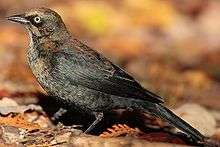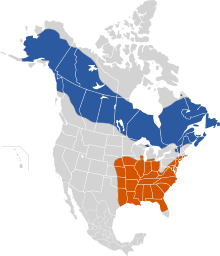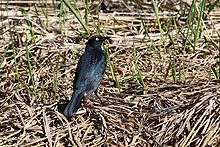Rusty blackbird
The rusty blackbird (Euphagus carolinus) is a medium-sized blackbird, closely related to grackles ("rusty grackle" is an older name for the species). It is a bird that prefers wet forested areas, breeding in the boreal forest and muskeg across northern Canada, and migrating southeast to the United States during winter.
| Rusty blackbird | |
|---|---|
 | |
| Scientific classification | |
| Kingdom: | Animalia |
| Phylum: | Chordata |
| Class: | Aves |
| Order: | Passeriformes |
| Family: | Icteridae |
| Genus: | Euphagus |
| Species: | E. carolinus |
| Binomial name | |
| Euphagus carolinus (Muller, 1776) | |
 | |
| Range of E. carolinus Breeding range Wintering range | |
Formerly abundant, the rusty blackbird has undergone one of the most rapid declines of any abundant bird species in North America in recent years, for reasons that are not well understood.
Description
Adults have a pointed bill and a pale yellow eye. They have black plumage with faint green and purple gloss; the female is greyer. "Rusty" refers to the brownish winter plumage. They resemble the western member of the same genus, the Brewer's blackbird; however, Brewer's has a longer bill and the male's head is iridescent green.
| Standard Measurements[2][3] | |
|---|---|
| length | 8.5–9.8 in (220–250 mm) |
| weight | 60 g (2.1 oz) |
| wingspan | 14 in (360 mm) |
| wing | 110.5–117.4 mm (4.35–4.62 in) |
| tail | 85–94.5 mm (3.35–3.72 in) |
| culmen | 19–21.9 mm (0.75–0.86 in) |
| tarsus | 29.5–33 mm (1.16–1.30 in) |

Habitat
Their breeding habitat is wet temperate coniferous forests and muskeg across Canada and Alaska. Birds usually nest at the edge of ponds and wetlands with the cup nest located in a tree or dense shrub, often over the water. Emerging dragonflies and their larvae are important food items during the summer.
These birds migrate to the eastern and southeastern United States, into parts of the Grain Belt, sometimes straying into Mexico.
Behavior
They forage on wet ground or in shallow water, mainly eating insects, small fish and some seeds. Their most common mode of foraging is to vigorously flip leaves and rip at submerged aquatic vegetation. The mast of small-acorn producing oaks, such as willow oak, is also important. In some areas, the nuts of planted pecans are heavily used. They very rarely will attack small passerine birds, and have been known to kill species as large as the common snipe. They feed in flocks during migration and on the wintering grounds, sometimes joining other blackbirds, both often occurring in single species flocks. They more often roost with other blackbirds; some small roosts are in brushy vegetation in old fields and others are in massive mixed flocks—sometimes in the urban areas.
The species nests relatively early for a boreal forest bird. They linger in the boreal zone to complete their molt. Their autumn migration is slow, with birds often remaining in the northern states well into December; spring migration is much more rapid. The largest wintering concentrations are found in the lower Mississippi Valley, with smaller concentrations in the Piedmont and south Atlantic coastal plain.
Fairly quiet in fall migration and most of the winter, both males and females will sing (particularly on warm days) in the late winter and spring. The song consists of gurgling and high-pitched squeaks.
Population
Rusty blackbirds have declined significantly in recent decades. The reasons are unclear, but habitat loss is likely a major contributor to the decline. The habitat loss is likely due to multiple factors, including development for oil, gas, and mining industries, hydroelectric projects, and the clearing of forests for forestry.[4] Mercury contamination may be a problem for populations in northeastern North America. Rarer than previously believed, it was uplisted from a species of Least Concern to Vulnerable status on the 2007 IUCN Red List.[5][6] Deliberate poisoning of mixed-species blackbird flocks, targeting brown-headed cowbird, common grackle and red-winged blackbird, in the southeastern U.S. Wwe may also be playing a role; there is currently no estimate of the number of rusty blackbirds killed by these poisonings.[4] In the eastern part of its range, acid rain may be decreasing the availability of calcium-rich invertebrates that the rusty blackbird depends on for food.[4]
Additionally, citizen science projects such as the North American Breeding Bird Survey and Christmas Bird Count have determined that rusty blackbirds have dropped 85%–98% in the past 40 years. This is very worrisome for many people, as scientists are desperately trying to figure out what exactly went wrong. Sighting submission services such as eBird are encouraging birders to keep track of rusty blackbirds. The International Rusty Blackbird Working Group has been actively coordinating and conducting research on this species since 2005.
References
- BirdLife International (2012). "Euphagus carolinus". IUCN Red List of Threatened Species. 2012. Retrieved 26 November 2013.CS1 maint: ref=harv (link)
- Godfrey, W. Earl (1966). The Birds of Canada. Ottawa: National Museum of Canada. p. 358.
- Sibley, David Allen (2000). The Sibley Guide to Birds. New York: Knopf. p. 514. ISBN 0-679-45122-6.
- Wells, Jeffrey V. (2007). Birder's Conservation Handbook. Princeton University Press. ISBN 978-0691123233.
- "2006-2007 Red List status changes". BirdLife International. Archived from the original on 28 August 2007. Retrieved 26 August 2007.
- BirdLife species factsheet for Euphagus carolinus
- Jaramillo, Alvaro; Burke, Peter (1999). New World Blackbirds. London: Christopher Helm. ISBN 0-7136-4333-1.
External links
| Wikimedia Commons has media related to Euphagus carolinus. |
| Wikispecies has information related to Euphagus carolinus |
- The International Rusty Blackbird Working Group
- Rusty Blackbird Species Account - Cornell Lab of Ornithology
- Rusty Blackbird - Euphagus carolinus - USGS Patuxent Bird Identification InfoCenter
- "Rusty blackbird media". Internet Bird Collection.
- Rusty blackbird photo gallery at VIREO (Drexel University)
- Audio recordings of Rusty Blackbird on Xeno-canto.
